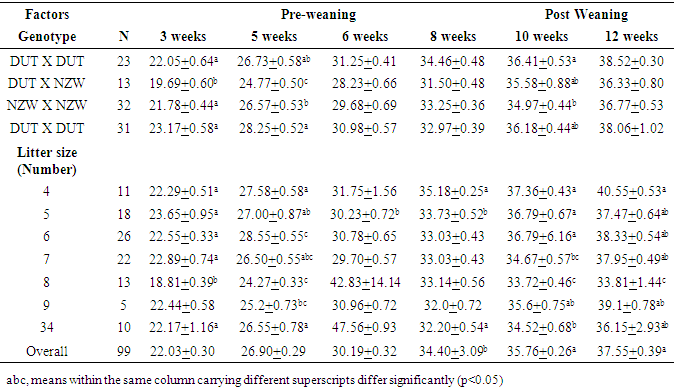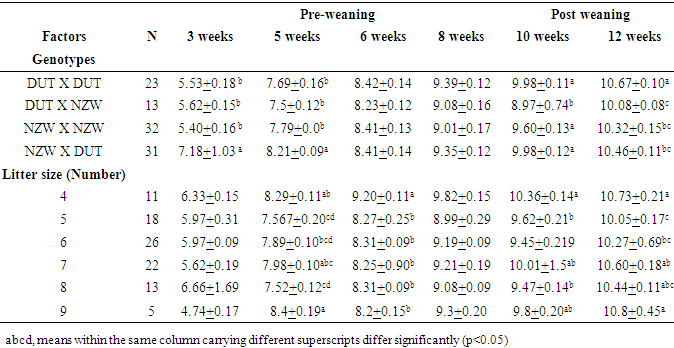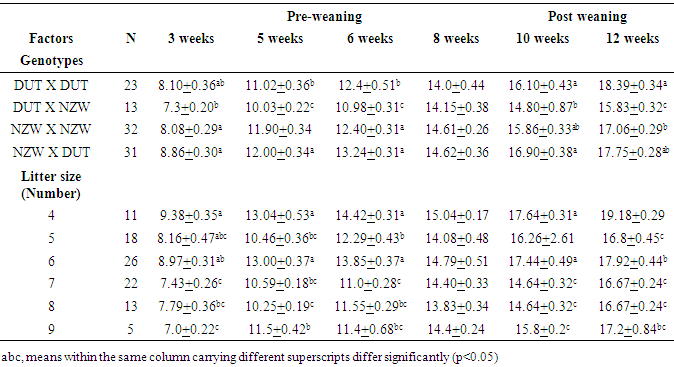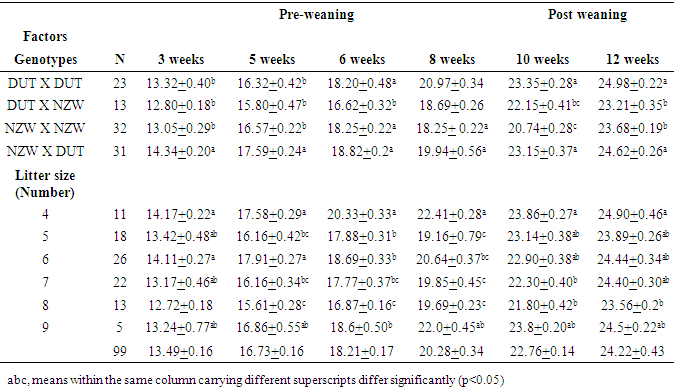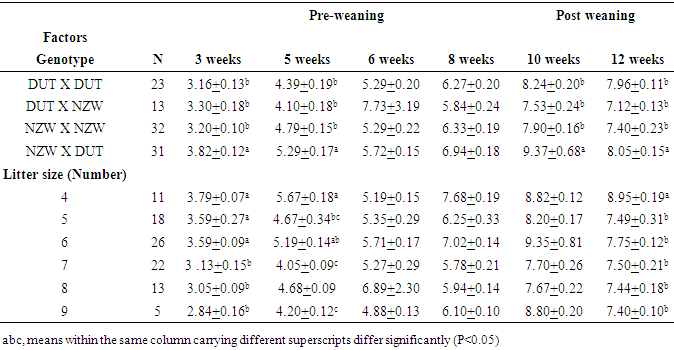-
Paper Information
- Next Paper
- Paper Submission
-
Journal Information
- About This Journal
- Editorial Board
- Current Issue
- Archive
- Author Guidelines
- Contact Us
International Journal of Agriculture and Forestry
p-ISSN: 2165-882X e-ISSN: 2165-8846
2018; 8(2): 63-69
doi:10.5923/j.ijaf.20180802.03

Pre-Weaning and Post Weaning Growth Performance of Rabbits: Influence of Genotype and Litter Size in a Humid Tropical Environment
Ajayi F. O., Ologbose F. I., Esenowo E. S.
Department of Animal Science, Faculty of Agriculture, University of Port Harcourt, Choba, Port Harcourt, Rivers State, Nigeria
Correspondence to: Ajayi F. O., Department of Animal Science, Faculty of Agriculture, University of Port Harcourt, Choba, Port Harcourt, Rivers State, Nigeria.
| Email: |  |
This work is licensed under the Creative Commons Attribution International License (CC BY).
http://creativecommons.org/licenses/by/4.0/

The effect of genotype and litter size on pre-weaning and post weaning body weight and linear body measurements of rabbits was observed using two breeds of rabbits- Dutch belted (Dutch) (DUT) and New Zealand White (NZW) rabbits. Four genetic groups were generated from the two breeds namely: (DUT X DUT, NZW X NZW, DUT X NZW and NZW X DUT. Ninety nine offspring obtained from these crossbreeding systems were used for the experiment. Genotype significantly (p <0.05) influenced body weight at pre-weaning (1, 3, 5, 6, 8 weeks of age) and post weaning (10 and 12 weeks of age). The NZW X DUT crossbreds were significantly higher in body weight than two purebreds (NZW and DUT) and the DUT X NZW cross. Does with small litter size (4) consistently had (p<0.05) highest body weight across the weeks considered. Litter size (4) had the highest body length (40.55 ± 0.53cm). There was no significant difference (p<0.05) between litter size (5) (37.47 ± 0.64cm), (6) (38.33 ± 0.54cm), 7 (37.95 ± 0.49cm) and 9 (39.10 ± 0.78). Breed significantly (p<0. 05) affected ear length at 56, 70 and 84 days old. Rabbits in small litter size grow faster than those in larger litter size. It was concluded that variation exist in body weight and body measurements for the two breeds of rabbit used for this research. Crossbreeding to improve the efficiency of rabbit meat should be encouraged for maximum productivity.
Keywords: Genotype, Litter size, Body weight, Linear body measurements
Cite this paper: Ajayi F. O., Ologbose F. I., Esenowo E. S., Pre-Weaning and Post Weaning Growth Performance of Rabbits: Influence of Genotype and Litter Size in a Humid Tropical Environment, International Journal of Agriculture and Forestry, Vol. 8 No. 2, 2018, pp. 63-69. doi: 10.5923/j.ijaf.20180802.03.
Article Outline
1. Introduction
- Rabbits have high potential in the production of high quantity of meat compared to other farm animals. For this reason, rabbits can as well serve as a good source of cheap animal protein in order to prevent the consequences of malnutrition in infants and adults which are widespread in developing countries such as the one prevalent in Nigeria. Rabbit meat provides a good source meat which is characterized by high protein and low fat cholesterol contents with low cost (Aduku and Olukosi, 1990).Earlier reports have shown that pre-weaning variables are major contributory factors affecting post weaning performance of rabbits (Lukefahr et al., 1990; McNitt and Moody, 1988). This means that better weaning and post weaning growth performance of rabbits could be achieved through the improvement of traits at pre-weaning. Efficiency of meat production in rabbits can be enhanced through crossbreeding. This is because additive genetic effects as opposed to other genetic effects has been implicated for pre-weaning litter traits and post weaning growths along with carcass performance in rabbits (Afifi and Khalil, 1991; Youssef, 1992; Khalil and Afifi, 1994). With good knowledge of genetic parameters of economic traits in rabbits, breeders can easily choose which breed to cross to utilize positive heterosis (Akanno and Ibe, 2005). Heterosis usually occurs when the breeds crossed differ genetically.Economic traits to be genetically improved for maximum productivity in rabbit production are litter size and litter weight. Litters body weight at weaning is influenced by the number of kits survived at weaning (Risam et al. 2005). Ahmed et al. (2005) observed that California recorded higher litter size when compared with Baladi Red and New Zealand White. It was also observed that individual birth weight declined with increased in litter size. Rabbit Kittens of larger litter size always have a lower weight at weaning than the corresponding weight for kittens of smaller litter size (Poigner et al., 2000). This is due to the fact that their body weight gain depends on the quantity of milk consumed. Doe’s milk production is also positively correlated to litter size (Ayyat et al., 1995). According to Castellini et al., 2003, litter size at birth significantly influenced the post birth body weight of rabbit kits due to the fact that the quantity of milk per kiten decreased as the litter size increased. Ibrahim et al. (2003) reported a significant increase in pre weaning mortality for kits born in large litter in New Zealand White and other breeds of rabbits. Bhatt et al. (2002) found that litter size, weight at birth, litter size at weaning as well as litter weight at weaning were all higher in winter than during summer and the rainy season. Similar results were observed by Kumar et al. (2005) in Angola rabbits. Xiccato et al. (2004) revealed parity order can also lead to increase in litter size, while the average body weight of kittens borne alive reduced. Although pre-weaning litter traits in rabbits has been documented in Nigeria by some authors (Fayeye and Ayorinde, 2003; Obike and Ibe, 2010; Fayeye, 2013); limited information exist in literature on pre-weaning and post weaning growth performance of rabbits in the South-South region of Nigeria. The objective of this investigation was to evaluate and assess the influence of genotype and litter size on body weight and linear body measurements of rabbits at pre weaning and post weaning stages.
2. Materials and Methods
- The study was conducted at the rabbitry unit of Department of Animal Science, University of Port Harcourt Demonstration Farm (Livestock Section) Choba campus, Rivers State. The Campus is located at latitude 4.8943N and Longitude 6.91053 E. The altitude is 16m above sea level. Port Harcourt is classified as a tropical wet climate with very lengthy and heavy rainy seasons and very short dry seasons with annual average rainfall of 1950.7mm. Average temperatures are typically between 25°C-28°C in the city and relative humidity is about 85%.
3. Experimental Animals and Management
- Two breeds of rabbit were used for this experiment which includes New Zealand White (NZW) and Dutch (DUT). Four different genotypes were used as the breeding group: NZW X NZW, DUT X DUT, NZW X DUT and DUT X NZW. A total of ninety nine (99) kittens generated from the four genetic groups were used for this experiment. Total of twenty does (i.e. 10 Dutch and 10 New Zealand White) of 15 to 18 months old and four bucks (2 Dutch and 2 New Zealand White) were used for the experiment.The rabbits were fed with conventional pelleted growers feed and forages such as Calopogonium mucunoides and Panicum maximum ad libitum. Fresh drinking water was also served to the rabbits. Other daily routine management practices were carried out regularly. The rabbits were housed in cages and kindling boxes were provided kindling. The kittens were weaned at 56days of age.
4. Data Collection
- Body weight of rabbits was taken using top loading weighing scale while, linear body measurements were taken using measuring tape on weekly basis. Litter traits studied include; Litter size, Total number weaned and litter body weight at birth. Linear body measurements such as body length, ear length, fore limb length, hind limb length ear length and tail length. Body length was measured using measuring tape from the tip of the nose to the beginning of the tail. Ear length was measured from the point of attachment of the ear close to the skull to the tip of the ear. Tail length was measured from the end of the keel to the tip of the tail. Fore limb is measured from the joint of the shoulder to the tip of the claw. Hind limb length is taken from the pelvic girdle to the claw of the hind limb.Statistical AnalysisThe body weight and linear body measurements means at the various ages by genotype, litter sizes and gestation length were analyzed using the General Linear Model of SAS (2001).The Linear model is as presented below;
 Where Yijkl = Record of the dependent variableµ= Overall meanGi = Effect of the ith genotype (i = 1-4)Cj = Effect of the jth litter size (j = 1-6)Eijkl = Random error effect
Where Yijkl = Record of the dependent variableµ= Overall meanGi = Effect of the ith genotype (i = 1-4)Cj = Effect of the jth litter size (j = 1-6)Eijkl = Random error effect5. Results
- Effect of Genotype and Litter Size on Body Weight of RabbitsThe effect of genotype on the body weight of rabbits is shown on Table 1. Genotype significantly (P<0.05) affected body weight and this increases from week 1 to week 12. There was no significant difference at week1 but at week 2, NZW X Dutch crosses had higher body weight (218.43 ± 8.44g) than other genotypes. This was closely followed by NZW X NZW crosses (198.59 ± 12.59g) and then Dutch x Dutch crosses (186.46 ± 16.55g). Dutch x NZW crosses had the lowest body weight (176.92 ± 15.36g). This trend was seen till week 6 when Dutch x Dutch over weighed NZW X NZW and this was maintained till the end of the research.The effect of litter size on body weight of the rabbits is also shown in Table 1. A significant difference (p <0.05) was seen in all the weeks. Rabbits with 4 litter size had the highest body weight across the weeks considered. The trend showed a reduced body weight as the number of litter increased. At week 12, litter size 4 had a body weight of 1245.46 ± 40.711g as compared to the least 933.33 ± 32.53g that was observed in litter size 8. Litter size 9 was slightly higher (1005.00 ± 15.00g).
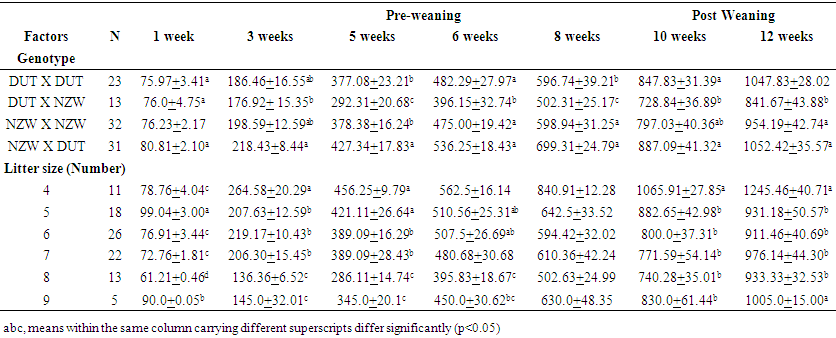 | Table 1. Effect of genotype and Litter Size on body weight (g) of Rabbits Pre-weaning and Post weaning stages |
|
|
|
|
|
6. Discussion
- The effect of genotype and litter size of rabbits on body weight was observed in this study. The results obtained are similar to those reported by Oke et al. (2011) and Isaac et al. (2010), where significant different was observed on body weight and other linear body parameters like ear length, fore limb length, hind limb length and tail length of rabbits. The present study contradicts the investigations of Ozimba and Lukefahr (1991) and Roberts and Lukefahr (1992) who concluded that there was little to non-significant breed differences for post weaning growth traits in breed comparison studies involving three different breeds of rabbits. The animals however, increased in body size and other body dimensions as the animals grew in age. In addition, environmental factors such as nutrition, disease, hormone and general management could lead to variation in growth rate or weight gain of rabbit within the same breed or among different breeds. According to Ayorinde and Oke (1995) variation in body weight within a flock can be as a result of the influence of the genetic variation and environmental factors on the animals. Body weight is regarded as a function of framework or size of the animal and its condition. Body weight is also known to be highly heritable and hence the selection of heavier individuals in a population should result in genetic improvement of the traits. (Poigner et al., 2000) also observed similar result as we observed that, individual birth weight declines with increase in litter size. Likewise, rabbit Kittens of larger litters also produced a lower weight at weaning than the corresponding weight for kittens of smaller litters. This could be their weight gain depends on the ability to consume more milk. Doe’s milk production is positively correlated to litter weight as reported by (Ayyat et al., 1995). According to (Castellini et al., 2003) the post birth body weight of rabbit kits is significantly influenced by litter size at birth due to the fact that the relative share of milk per kit decrease as the litter size increased.Castellini et al. (2003) also described that gestation period, kindling interval and litter weight at weaning are highly influenced by the effect of the season. Bhatt et al. (2002) found that litter size and weight at birth, litter size at weaning as well as litter weight at weaning were all higher during winter than those recorded during summer and the rainy season. Similar results were reported by Kumar et al. (2005) in Angola rabbits. Xiccato et al. (2004) revealed that the litter size increased with parity order, while the average weight of kits borne alive decreased. Similarly, crossbreeding is one of the fastest tools offered to the breeders to improve body weight and length of purebred animals.
7. Conclusions
- This study has shown that genotype and litter size significantly influence body weight, body length, ear length, fore limb and tail length of rabbits both at the pre-weaning and post weaning stages. Environmental factors such as nutrition, disease, hormone and general management are the major causes of variation in growth rate or weight gain of rabbit within the same breed or among different breeds of rabbit. Likewise, when there is increase in litter size, individual birth weight decreases and rabbit kits of larger litters also produced a lower weight at weaning than the corresponding weight for kits of smaller litters.
 Abstract
Abstract Reference
Reference Full-Text PDF
Full-Text PDF Full-text HTML
Full-text HTML